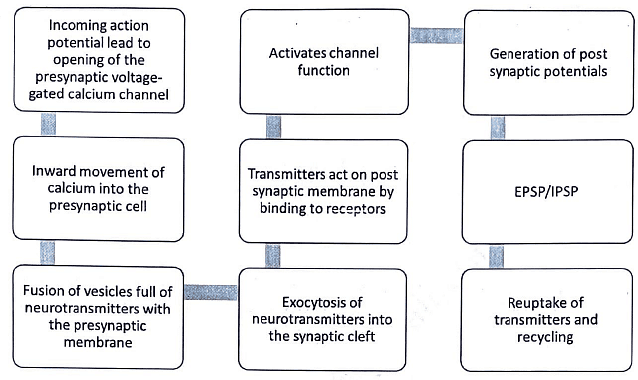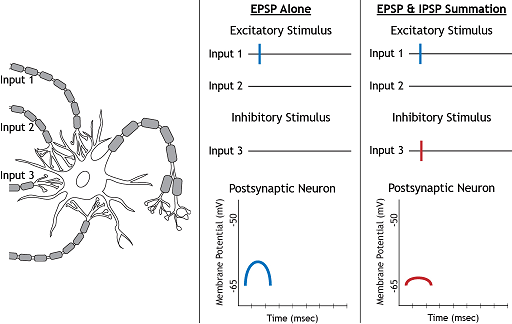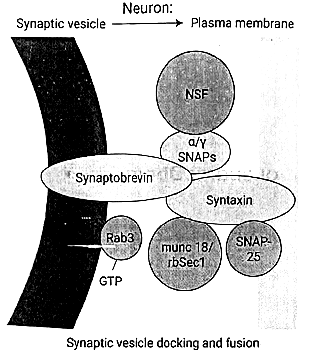Synapse-definition and Types | Medical Science Optional Notes for UPSC PDF Download
| Table of contents |

|
| Steps of synaptic transmission |

|
| Postsynaptic Potentials |

|
| Myasthenia Gravis Overview |

|
| Lambert-Eaton Syndrome Overview |

|
| Botulinum Toxins Overview |

|
| Tetanus Toxin Overview |

|
There are different types of synapses according to the synaptic structures:
- Axodendritic synapses: signaling between axons and dendrites
- Axoaxonic synapses: signaling between axons
- Axosomatic synapses: signaling between axons and the cell body of neurons
- Dendrodendritic synapses: signaling between dendrites

Steps of synaptic transmission

Postsynaptic Potentials
Excitatory Postsynaptic Potential (EPSP):
- Effect: Stimulates firing and propagation of the action potential.
- Mechanism: Result of increased Na+ influx into the cell.
- Examples:
- Neuromuscular junction.
- Nicotinic synapses (e.g., autonomic ganglia).
- NMDA synapses (e.g., glutamate and aspartate neurotransmitters).
Explanation:
- EPSPs depolarize the postsynaptic membrane, bringing it closer to the threshold for initiating an action potential.
- Commonly involves the opening of ligand-gated channels that allow Na+ ions to flow into the cell.
Inhibitory Postsynaptic Potential (IPSP):
- Effect: Decreases firing and propagation of the action potential.
- Mechanism: Result of increased influx of Cl- into the cell.
- Examples:
- GABAergic synapses.
- Glycine synapses (e.g., Renshaw cells in the spinal cord).
Explanation:
- IPSPs hyperpolarize the postsynaptic membrane, moving it away from the threshold for initiating an action potential.
- Typically involves the opening of ligand-gated channels that allow Cl- ions to flow into the cell.

The minimal period of time required for all these events to take place, even when large numbers of excitatory synapses are stimulated simultaneously, is about 0.5 millisecond, which is called the synaptic delay.
Significance
Neurophysiologists can measure the minimal delay time between an input volley of impulses into a pool of neurons and the consequent output volley. From the measure of delay time, one can then estimate the number of series neurons in the circuit.
Because the minimum time for transmission across one synapse is 0.5 ms, it is also possible to determine whether a given reflex pathway is monosynaptic or polysynaptic (contains more than one synapse) by measuring the synaptic delay.
Myasthenia Gravis Overview
Definition:
- MG is an autoimmune condition characterized by antibodies hindering neuromuscular transmission, leading to skeletal muscle weakness.
Autoimmune Attack:
- Autoantibodies develop against nicotinic acetylcholine receptors at the neuromuscular junction in skeletal muscles.
Clinical Hallmark:
- The main feature is variable muscle weakness intensifying with activity and easing during rest.
Triggers/Worsening Factors:
- Exacerbations can be prompted or aggravated by warm weather, surgery, immunization, emotional stress, and menstruation.
Diagnosis:
- Diagnosis involves a positive Anti-AChR radioimmunoassay, repetitive nerve stimulation indicating decrement, single-fiber electromyography showing blocking and jitter, and an edrophonium test.
Treatment:
- Management includes anticholinesterase (pyridostigmine) and options like thymectomy, plasmapheresis, or IVIG.
Lambert-Eaton Syndrome Overview
Autoimmune Mechanism:
- Muscle weakness results from an autoimmune attack on voltage-gated Ca2+ channels in nerve endings at the neuromuscular junction.
Impact on Ca2+ Influx:
- Autoimmune attack decreases the normal Ca2+ influx, impacting acetylcholine release.
Affected Muscles:
- Primarily affects proximal muscles of the lower extremities, leading to a waddling gait and difficulty raising the arms.
Association with Small Cell Carcinoma:
- Lambert-Eaton syndrome is often associated with small cell carcinoma (40%).
Comparison with Myasthenia Gravis:
- In Lambert-Eaton syndrome, repetitive stimulation of the motor nerve enhances Ca2+ accumulation in the nerve terminal, increasing acetylcholine release and muscle strength.
- This contrasts with myasthenia gravis, where symptoms worsen with repetitive stimulation.
Treatment:
- Treatment involves medications such as 3,4-diaminopyridine and pyridostigmine, along with therapeutic options like intravenous immunoglobulin (IVIG) and plasmapheresis.
Botulinum Toxins Overview
Toxin Family:
- Botulinum toxin comprises a family of seven neurotoxins, with primary relevance to humans for toxins A, B, and E.
Target Proteins:
- Botulinum toxins A and E cleave synaptosome-associated protein (SNAP-25), a crucial presynaptic membrane protein.
- Botulinum toxin B targets synaptobrevin, a vesicle-associated membrane protein (VAMP).
Mechanism:
- These toxins interfere with the fusion of synaptic vesicles containing acetylcholine to the terminal membrane, a critical step in transmitter release.
Effect on Neuromuscular Junction:
- By blocking acetylcholine release at the neuromuscular junction, botulinum toxins induce flaccid paralysis.
Symptoms:
- Clinical manifestations include ptosis, diplopia, dysarthria, dysphonia, and dysphagia.
Understanding the actions of botulinum toxins on synaptic proteins provides insight into their role in causing flaccid paralysis and associated symptoms.

 |
Download the notes
Synapse-definition and Types
|
Download as PDF |
Tetanus Toxin Overview
- Tetanus toxin, produced by Clostridium tetani, irreversibly binds to the presynaptic membrane at the neuromuscular junction.
- The toxin utilizes retrograde axonal transport to travel from the neuromuscular junction to the cell body of the motor neuron located in the spinal cord.
Nerve muscle physiology-Repeats
Synapse and NMJQ1: Describe the sequence of events during impulse transmission of neuromuscular junction. How can neuromuscular junction be blocked (1996)
Q2: Describe the sequence of events in neuromuscular transmission. What happens in myasthenia gravis (2005)?
Q3: Discuss in short the structure and sequence of events at neuromuscular junction during nerve impulse transmission. Add a note on myasthenia gravis. (2011)
Q4: Give the sequence of events that occurs during transmission of nerve impulse through neuromuscular junction. (2015)
Q5: Define synapse; enumerate the steps of synaptic transmission. What is the significance of Synaptic delay? (2013)
|
7 videos|219 docs
|
FAQs on Synapse-definition and Types - Medical Science Optional Notes for UPSC
| 1. What is synaptic transmission? |  |
| 2. What are postsynaptic potentials? |  |
| 3. What is Myasthenia Gravis? |  |
| 4. What is Lambert-Eaton Syndrome? |  |
| 5. What are Botulinum Toxins? |  |
















